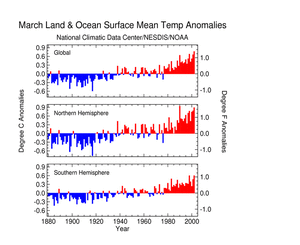Global Highlights:
- *Global average combined land and sea
surface temperature was the warmest on record for March
- Lower tropospheric temperatures were warmer than average
- March temperatures were greater than 4°C (7.2°F)
above average from eastern Europe to the Russian Far East
- Above average precipitation was most notable across northern
Argentina and Uruguay, with below average precipitation across much
of Australia and Brazil
|
|
Contents of this Section:
|
Introduction

larger
image
|
Temperature anomalies
calculated from in-situ station
data using a 1961-1990 base period also show the warmer than
average temperatures across Asia, Europe and Alaska with cooler
than average temperatures over central North America, central
Australia and southern Argentina and Chile. |
Temperature
- Although surface temperatures in the tropics have not reached
the warmth observed during the latter stages of the 1998 El
Niño episode, the global land and ocean temperature in March
2002 was the warmest in the 1880-2002 record, 0.77°C
(1.39°F) above the long-term average
- Temperatures averaged across land areas
were second warmest on record globally, or 1.50°C
(2.70°F) above the long-term March mean
- For the period January
through March, combined land and ocean temperatures tied with
the El Niño year of 1998 as warmest on record, 0.72°C
(1.30°F) above the mean
- Land areas experienced record warmth during the period
January-March, or 1.39°C (2.50°F) above the 1880-2001
average
|

larger
image
|

larger
image
|
- Based on data available at the time of this report, the global
average land and ocean temperature for the period October
2001-March 2002 was 0.63°C (1.13°F) above the 1880-2001
mean, the second warmest such period on record
- Record high global monthly temperatures were established in
January 2002 and November 2001
|
- Serial monthly global surface temperature departures with
respect to a 1971-2000 mean are shown in the figure to the
right
- The recent return to record or near record temperature
departures is evident, and monthly global temperatures (land and
ocean) have been warmer than the 1971-2000 average for the last 71
consecutive months
|

larger
image
|
Precipitation
- During March, much above average precipitation fell across
parts of northern Argentina, Uruguay and the U.S. Tennessee
Valley
- Drier than average weather prevailed across much of Australia,
Brazil, western Europe and much of the central and western
U.S.
- Additional regional analysis can be found on the Global
Regional page
|
 larger
image
larger
image
|
References:
Peterson, T.C. and R.S. Vose, 1997: An Overview of the Global
Historical Climatology Network Database. Bull. Amer. Meteorol.
Soc., 78, 2837-2849.
|






 NOAA's National Centers for Environmental Information
NOAA's National Centers for Environmental Information